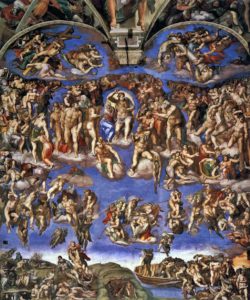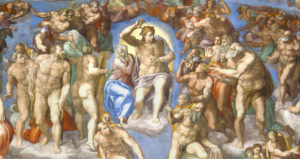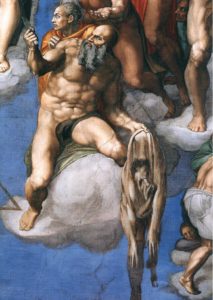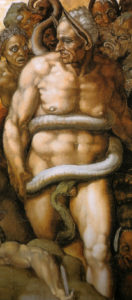The Last Judgment by Michelangelo
Italian version below*
Where did we stay on our journey into the art world?
Ah yes, we were in the Sistine Chapel, overwhelmed by Michelangelo’s charm.

However, a piece was missing, the last challenge that Michelangelo faces in that context, the Last Judgment commissioned by Paolo III Farnese in the years from 1536 to 1541 to complete a decoration that began years earlier with the Vault.
As much as the majesty of the work and that lapis lazuli blue take our breath away, the reading of the work is simple and linear.
Christ at the center of the composition is for the first time a young hero, the Virgin at her side is almost resigned because everything is done, the judgment is forever and she cannot intercede. The gesture of Christ initiates a rotating movement that involves all the figures.

There are the damned who are thrown into Hell, with the quote of Charon from Dante’s Divine Comedy, and the angels who play the book of Judgment.
On the sides of Christ and the Virgin, numerous Saints identifiable by the symbols of Martyrdom, St. Peter with the two keys, St. Lawrence with the grate, St. Catherine with the gear wheel, St. Bartholomew in whose skinned skin we want to recognize the self-portrait of Michelangelo, who await the verdict.

Before Michelangelo made the Last Judgment, a work by Perugino with the Assumption of the Virgin stood on the Sistine altar.
It was foreseeable that a work such as the Last Judgment would scandalize many contemporary Michelangelo characters.
The chronicles tell that in 1540 when the scaffolding before the Judgment was temporarily removed, the Pope’s master of ceremonies, Biagio da Cesena, Michelangelo’s enemy, wasted no time in criticizing the fresco and underlining how obscene it was that they concentrated in the Pope’s Magna Chapel, many nudes, buttocks, and sexes.
Michelangelo known for his non-docile character, shortly after being the Judgment yet to be completed, portrayed the figure of Minos with a snake that envelops him and bites his “member”, and gave him the features of Biagio da Cesena.

Looking at the Judgment, the figure of Minos is placed at the bottom right, above the entrance door of the Sistine.
Nothing is left to chance, it was impossible for anyone arriving in Sistine, not to notice Minos!
As long as Michelangelo was alive, no one tried to modify the work.
When the artist died in 1564, his best pupil Daniele da Volterra was called to cover the “nudes” with breeches from which then the nickname was given to him as “the braghettone”.
Over the centuries with several restorations the “brechees” were removed and the work returned to be faithful to what the genius had created.
Tell the Pope that you think he can fix the Church, that the frescoes are easily accommodated.
InfoSite: Vatican Museums
All rights reserved*
Dove eravamo rimasti nel nostro viaggio nel mondo dell’arte?
Ah si, eravamo in Cappella Sistina, travolti dal fascino di Michelangelo.
Mancava però un pezzo, l’ultima sfida che Michelangelo affronta in quel contesto, il Giudizio Universale. L’opera gli viene commissionata da Paolo III Farnese negli anni dal 1536 al 1541 a compimento di una decorazione iniziata anni prima con la Volta.
Per quanto la maestosità del lavoro e di quel blu lapislazzolo ci tolgono il respiro, la lettura dell’opera è semplice e lineare.

Cristo al Centro della composizione è per la prima volta un giovane eroe.
La Madonna al suo fianco è quasi rassegnata, perchè tutto è compiuto, il Giudizio è per sempre e lei non può intercedere. Il gesto di Cristo da avvio ad un movimento rotatorio che coinvolge tutte le figure.

Ci sono i dannati che vengono buttati nell’Inferno, con la citazione di Caronte dalla Divina Commedia di Dante; gli angeli che suonano il libro del Giudizio. Ai lati di Cristo e la Vergine, numerosi Santi identificabili dai simboli del Martirio, San Pietro con le due chiavi, San Lorenzo con la graticola, Santa Caterina con la ruota dentata, San Bartolomeo nella cui pelle scuoiata si vuole ravvisare l’autoritratto di Michelangelo, che attendono il verdetto.

Prima che Michelangelo realizzasse il Giudizio Universale, sull’altare della Sistina si ergeva un’opera del Perugino con l’Assunzione della Vergine.
Era prevedibile che un’opera come il Giudizio scandalizzasse molti personaggi a Michelangelo contentemporanei. Raccontano le cronache che nel 1540 quando i ponteggi dinanzi al Giudizio vennero momentaneamente rimossi, il cerimoniere del Papa, Biagio da Cesena, nemico di Michelangelo non perse tempo per criticare l’affresco e sottolineare come era cosa oscena che nella Cappella Magna del Papa si concentrassero, tanti nudi, natiche e sessi.
Michelangelo noto per il suo carattere non docile, di lì a poco essendo il Giudizio ancora da ultimare relizzò la figura di Minosse con un serpente che lo avvolge e gli morde il “membro”, e gli diede le fattezze di Biagio da Cesena. Guardando il Giudizio, la figura di Minosse è posta in basso a destra, al di sopra della porta di ingresso della Sistina.

Nulla è lasciato al caso, era impossibile per chiunque arrivasse in Sistina, non notare Minosse!
Fino a quando Michelangelo fu vivo nessuno provò a modificare l’opera.
Quando l’artista morì nel 1564, fu chiamato il suo miglior allievo Daniele da Volterra a ricoprire i “nudi” con delle braghe da cui poi il soprannome che gli fu dato come “il braghettone”.
Nel corso dei secoli con i numerosi interventi di restauro, le braghe furono rimosse e l’opera tornò ad essere fedele a ciò che il genio aveva creato.
Dite al Papa che pensi lui ad aggiustare la Chiesa, che gli affreschi si accomodano facilmente.
InfoSite: Musei Vaticani
Tutti i diritti sono riservati. E’ vietata qualsiasi utilizzazione, totale o parziale, dei contenuti inseriti nel presente portale, ivi inclusa la memorizzazione, riproduzione, rielaborazione, diffusione o distribuzione dei contenuti stessi mediante qualunque piattaforma tecnologica, supporto o rete telematica, senza previa autorizzazione scritta di Selenia Morgillo.